Corporations and Business Structures: Commercial Law Assignment Report
VerifiedAdded on 2023/01/11
|6
|2315
|80
Report
AI Summary
This report, addressing a Commercial and Corporation Law assignment, meticulously examines various business structures including sole traders, partnerships, and proprietary companies, comparing their start-up and administrative costs, as well as the legal formalities associated with each. Part A focuses on the financial implications, while Part B delves into the personal liabilities of owners, contrasting the limited liability of companies with the unlimited liability of partnerships, supported by the landmark case of Salomon v A Salomon and Co Ltd. Part C then explores the duties of directors and partners, including fiduciary and statutory obligations, emphasizing the importance of good faith, avoidance of conflicts of interest, and adherence to the Corporations Act 2001. The analysis incorporates key case laws and statutory provisions to provide a comprehensive understanding of corporate governance and business law principles.
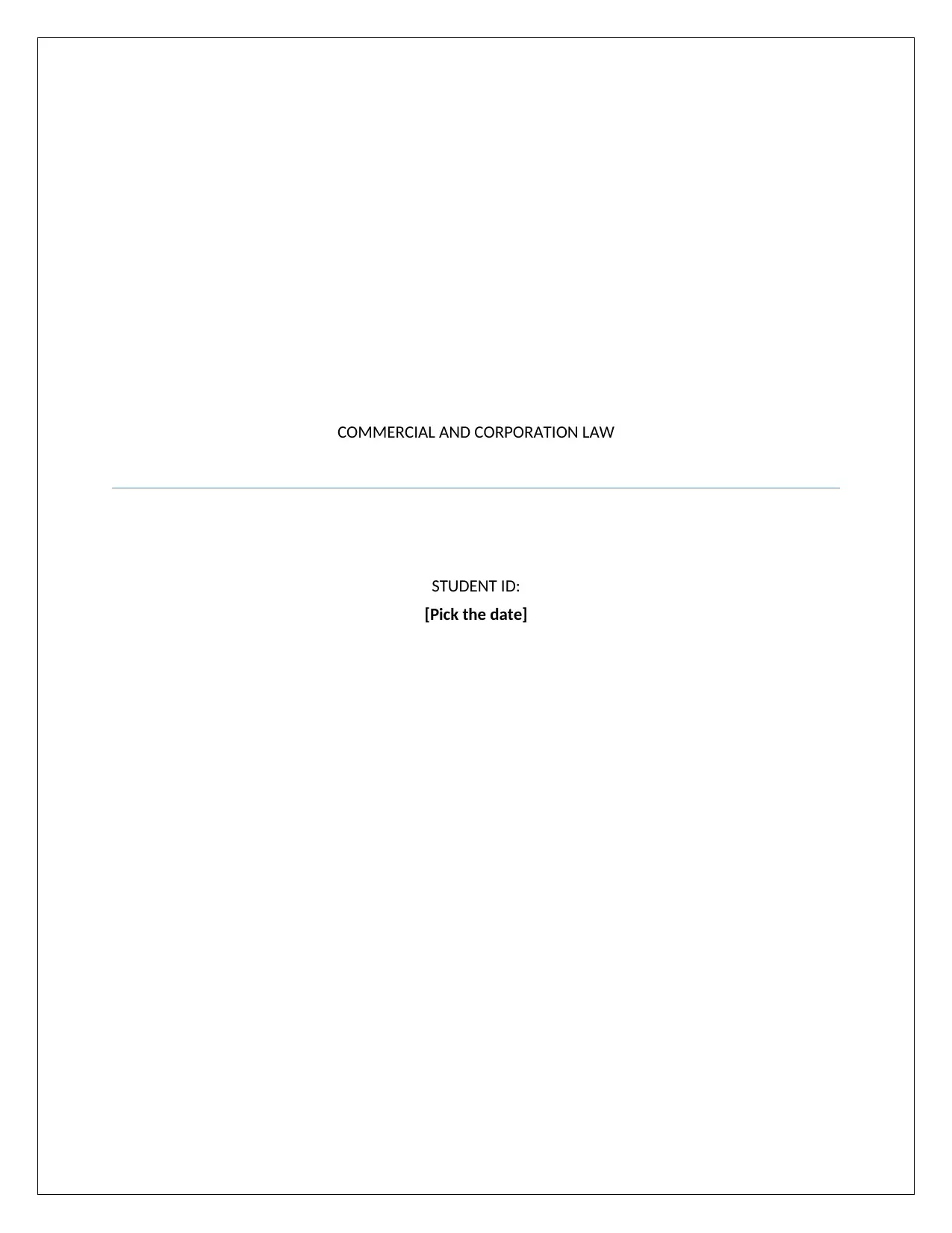
COMMERCIAL AND CORPORATION LAW
STUDENT ID:
[Pick the date]
STUDENT ID:
[Pick the date]
Paraphrase This Document
Need a fresh take? Get an instant paraphrase of this document with our AI Paraphraser
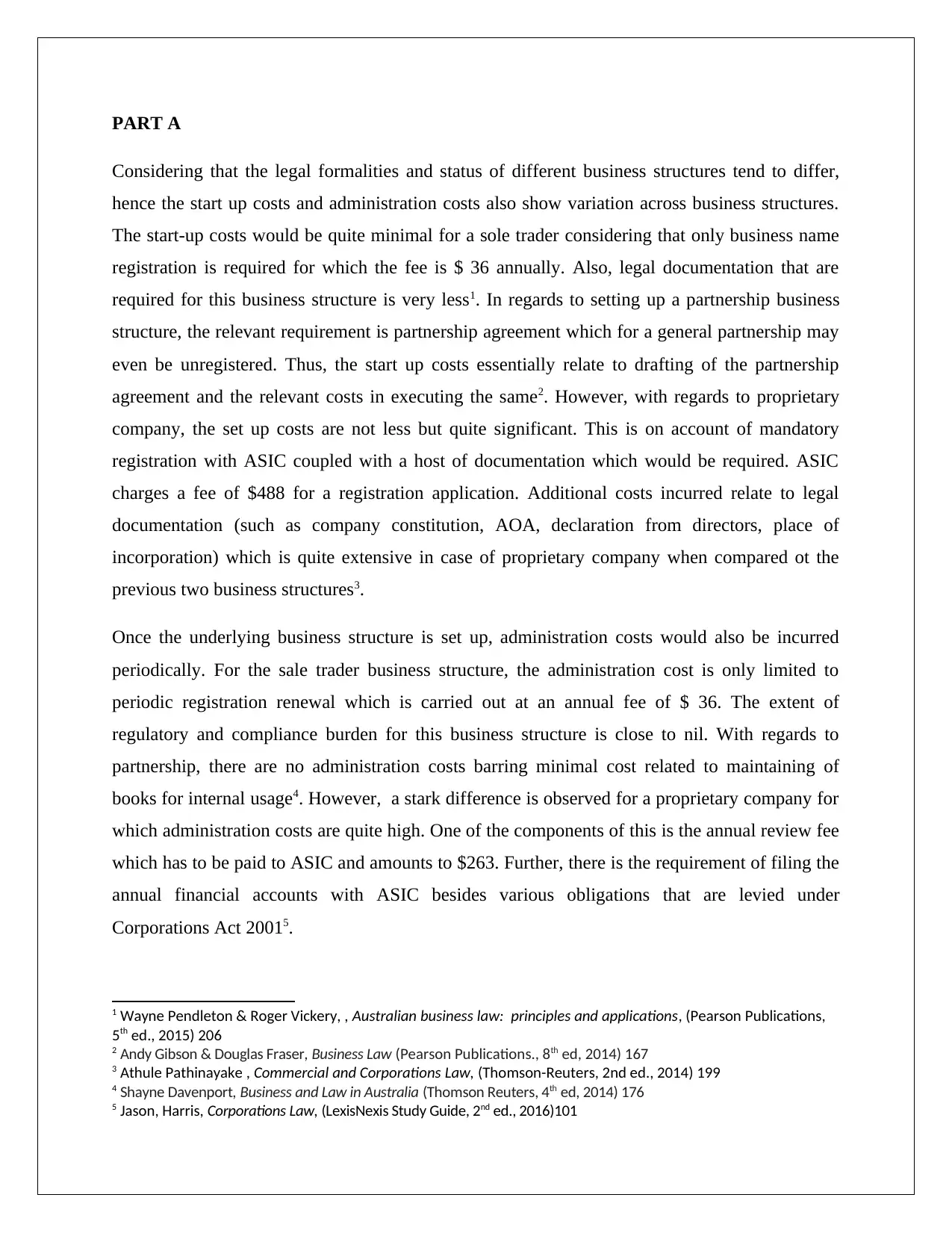
PART A
Considering that the legal formalities and status of different business structures tend to differ,
hence the start up costs and administration costs also show variation across business structures.
The start-up costs would be quite minimal for a sole trader considering that only business name
registration is required for which the fee is $ 36 annually. Also, legal documentation that are
required for this business structure is very less1. In regards to setting up a partnership business
structure, the relevant requirement is partnership agreement which for a general partnership may
even be unregistered. Thus, the start up costs essentially relate to drafting of the partnership
agreement and the relevant costs in executing the same2. However, with regards to proprietary
company, the set up costs are not less but quite significant. This is on account of mandatory
registration with ASIC coupled with a host of documentation which would be required. ASIC
charges a fee of $488 for a registration application. Additional costs incurred relate to legal
documentation (such as company constitution, AOA, declaration from directors, place of
incorporation) which is quite extensive in case of proprietary company when compared ot the
previous two business structures3.
Once the underlying business structure is set up, administration costs would also be incurred
periodically. For the sale trader business structure, the administration cost is only limited to
periodic registration renewal which is carried out at an annual fee of $ 36. The extent of
regulatory and compliance burden for this business structure is close to nil. With regards to
partnership, there are no administration costs barring minimal cost related to maintaining of
books for internal usage4. However, a stark difference is observed for a proprietary company for
which administration costs are quite high. One of the components of this is the annual review fee
which has to be paid to ASIC and amounts to $263. Further, there is the requirement of filing the
annual financial accounts with ASIC besides various obligations that are levied under
Corporations Act 20015.
1 Wayne Pendleton & Roger Vickery, , Australian business law: principles and applications, (Pearson Publications,
5th ed., 2015) 206
2 Andy Gibson & Douglas Fraser, Business Law (Pearson Publications., 8th ed, 2014) 167
3 Athule Pathinayake , Commercial and Corporations Law, (Thomson-Reuters, 2nd ed., 2014) 199
4 Shayne Davenport, Business and Law in Australia (Thomson Reuters, 4th ed, 2014) 176
5 Jason, Harris, Corporations Law, (LexisNexis Study Guide, 2nd ed., 2016)101
Considering that the legal formalities and status of different business structures tend to differ,
hence the start up costs and administration costs also show variation across business structures.
The start-up costs would be quite minimal for a sole trader considering that only business name
registration is required for which the fee is $ 36 annually. Also, legal documentation that are
required for this business structure is very less1. In regards to setting up a partnership business
structure, the relevant requirement is partnership agreement which for a general partnership may
even be unregistered. Thus, the start up costs essentially relate to drafting of the partnership
agreement and the relevant costs in executing the same2. However, with regards to proprietary
company, the set up costs are not less but quite significant. This is on account of mandatory
registration with ASIC coupled with a host of documentation which would be required. ASIC
charges a fee of $488 for a registration application. Additional costs incurred relate to legal
documentation (such as company constitution, AOA, declaration from directors, place of
incorporation) which is quite extensive in case of proprietary company when compared ot the
previous two business structures3.
Once the underlying business structure is set up, administration costs would also be incurred
periodically. For the sale trader business structure, the administration cost is only limited to
periodic registration renewal which is carried out at an annual fee of $ 36. The extent of
regulatory and compliance burden for this business structure is close to nil. With regards to
partnership, there are no administration costs barring minimal cost related to maintaining of
books for internal usage4. However, a stark difference is observed for a proprietary company for
which administration costs are quite high. One of the components of this is the annual review fee
which has to be paid to ASIC and amounts to $263. Further, there is the requirement of filing the
annual financial accounts with ASIC besides various obligations that are levied under
Corporations Act 20015.
1 Wayne Pendleton & Roger Vickery, , Australian business law: principles and applications, (Pearson Publications,
5th ed., 2015) 206
2 Andy Gibson & Douglas Fraser, Business Law (Pearson Publications., 8th ed, 2014) 167
3 Athule Pathinayake , Commercial and Corporations Law, (Thomson-Reuters, 2nd ed., 2014) 199
4 Shayne Davenport, Business and Law in Australia (Thomson Reuters, 4th ed, 2014) 176
5 Jason, Harris, Corporations Law, (LexisNexis Study Guide, 2nd ed., 2016)101
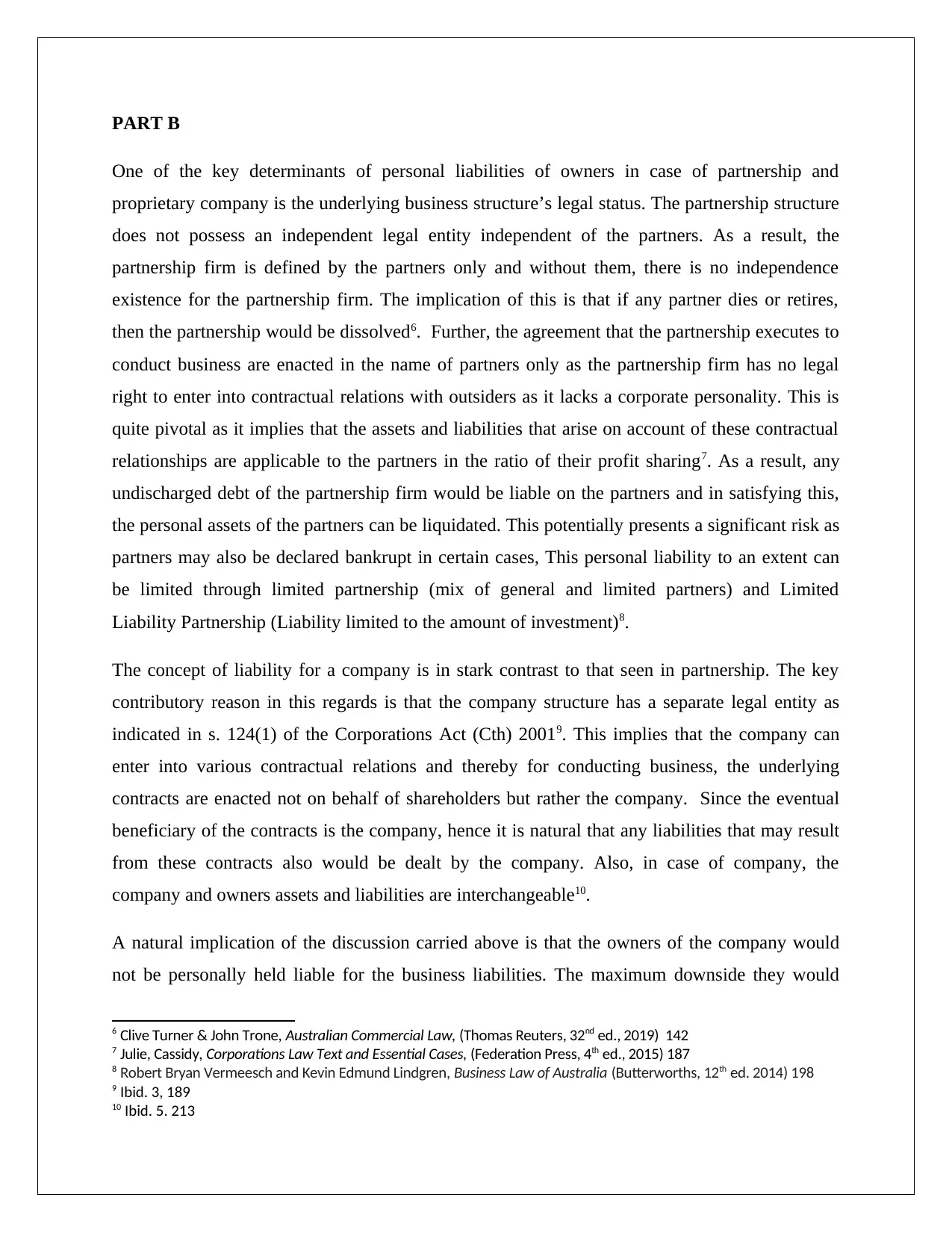
PART B
One of the key determinants of personal liabilities of owners in case of partnership and
proprietary company is the underlying business structure’s legal status. The partnership structure
does not possess an independent legal entity independent of the partners. As a result, the
partnership firm is defined by the partners only and without them, there is no independence
existence for the partnership firm. The implication of this is that if any partner dies or retires,
then the partnership would be dissolved6. Further, the agreement that the partnership executes to
conduct business are enacted in the name of partners only as the partnership firm has no legal
right to enter into contractual relations with outsiders as it lacks a corporate personality. This is
quite pivotal as it implies that the assets and liabilities that arise on account of these contractual
relationships are applicable to the partners in the ratio of their profit sharing7. As a result, any
undischarged debt of the partnership firm would be liable on the partners and in satisfying this,
the personal assets of the partners can be liquidated. This potentially presents a significant risk as
partners may also be declared bankrupt in certain cases, This personal liability to an extent can
be limited through limited partnership (mix of general and limited partners) and Limited
Liability Partnership (Liability limited to the amount of investment)8.
The concept of liability for a company is in stark contrast to that seen in partnership. The key
contributory reason in this regards is that the company structure has a separate legal entity as
indicated in s. 124(1) of the Corporations Act (Cth) 20019. This implies that the company can
enter into various contractual relations and thereby for conducting business, the underlying
contracts are enacted not on behalf of shareholders but rather the company. Since the eventual
beneficiary of the contracts is the company, hence it is natural that any liabilities that may result
from these contracts also would be dealt by the company. Also, in case of company, the
company and owners assets and liabilities are interchangeable10.
A natural implication of the discussion carried above is that the owners of the company would
not be personally held liable for the business liabilities. The maximum downside they would
6 Clive Turner & John Trone, Australian Commercial Law, (Thomas Reuters, 32nd ed., 2019) 142
7 Julie, Cassidy, Corporations Law Text and Essential Cases, (Federation Press, 4th ed., 2015) 187
8 Robert Bryan Vermeesch and Kevin Edmund Lindgren, Business Law of Australia (Butterworths, 12th ed. 2014) 198
9 Ibid. 3, 189
10 Ibid. 5. 213
One of the key determinants of personal liabilities of owners in case of partnership and
proprietary company is the underlying business structure’s legal status. The partnership structure
does not possess an independent legal entity independent of the partners. As a result, the
partnership firm is defined by the partners only and without them, there is no independence
existence for the partnership firm. The implication of this is that if any partner dies or retires,
then the partnership would be dissolved6. Further, the agreement that the partnership executes to
conduct business are enacted in the name of partners only as the partnership firm has no legal
right to enter into contractual relations with outsiders as it lacks a corporate personality. This is
quite pivotal as it implies that the assets and liabilities that arise on account of these contractual
relationships are applicable to the partners in the ratio of their profit sharing7. As a result, any
undischarged debt of the partnership firm would be liable on the partners and in satisfying this,
the personal assets of the partners can be liquidated. This potentially presents a significant risk as
partners may also be declared bankrupt in certain cases, This personal liability to an extent can
be limited through limited partnership (mix of general and limited partners) and Limited
Liability Partnership (Liability limited to the amount of investment)8.
The concept of liability for a company is in stark contrast to that seen in partnership. The key
contributory reason in this regards is that the company structure has a separate legal entity as
indicated in s. 124(1) of the Corporations Act (Cth) 20019. This implies that the company can
enter into various contractual relations and thereby for conducting business, the underlying
contracts are enacted not on behalf of shareholders but rather the company. Since the eventual
beneficiary of the contracts is the company, hence it is natural that any liabilities that may result
from these contracts also would be dealt by the company. Also, in case of company, the
company and owners assets and liabilities are interchangeable10.
A natural implication of the discussion carried above is that the owners of the company would
not be personally held liable for the business liabilities. The maximum downside they would
6 Clive Turner & John Trone, Australian Commercial Law, (Thomas Reuters, 32nd ed., 2019) 142
7 Julie, Cassidy, Corporations Law Text and Essential Cases, (Federation Press, 4th ed., 2015) 187
8 Robert Bryan Vermeesch and Kevin Edmund Lindgren, Business Law of Australia (Butterworths, 12th ed. 2014) 198
9 Ibid. 3, 189
10 Ibid. 5. 213
⊘ This is a preview!⊘
Do you want full access?
Subscribe today to unlock all pages.

Trusted by 1+ million students worldwide
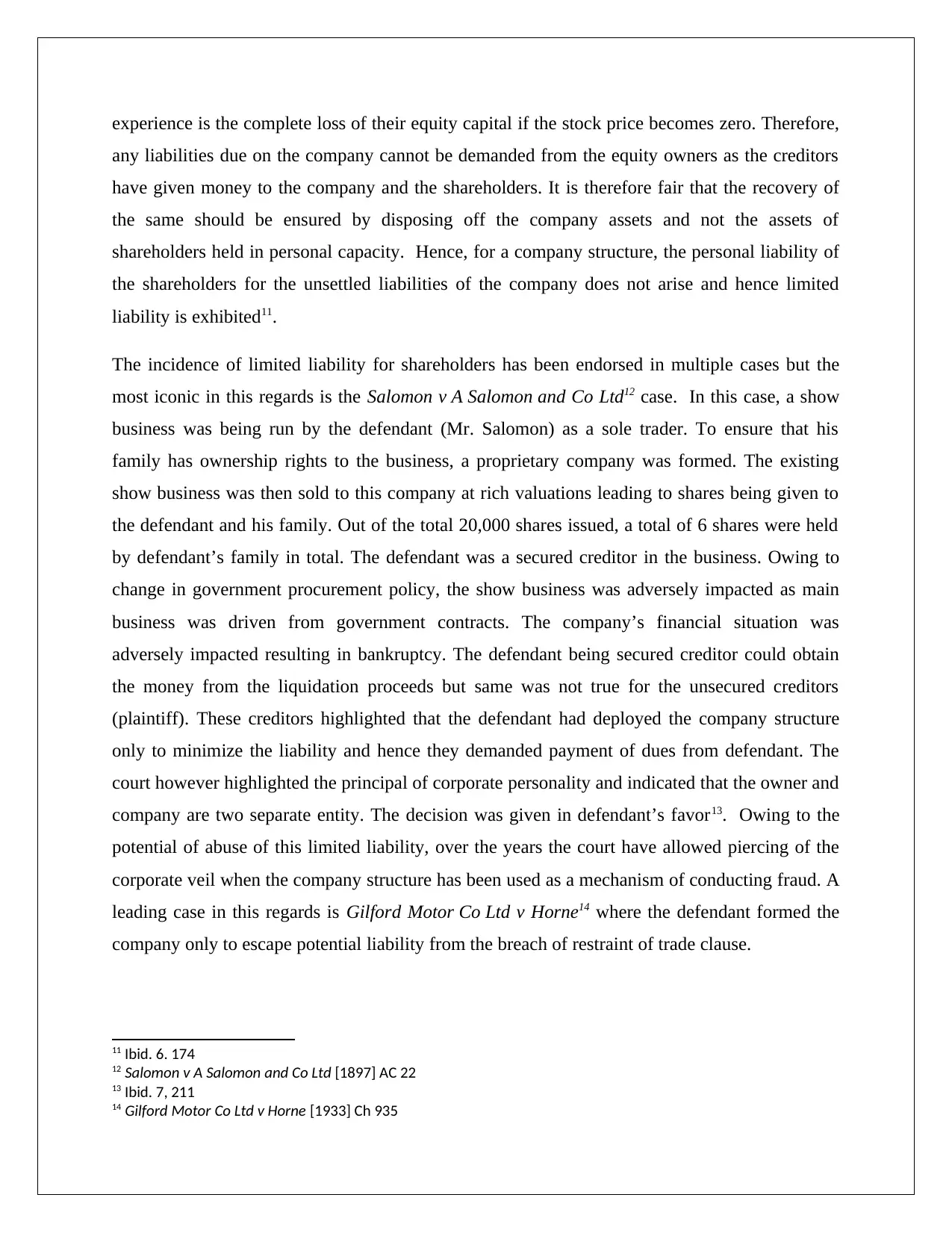
experience is the complete loss of their equity capital if the stock price becomes zero. Therefore,
any liabilities due on the company cannot be demanded from the equity owners as the creditors
have given money to the company and the shareholders. It is therefore fair that the recovery of
the same should be ensured by disposing off the company assets and not the assets of
shareholders held in personal capacity. Hence, for a company structure, the personal liability of
the shareholders for the unsettled liabilities of the company does not arise and hence limited
liability is exhibited11.
The incidence of limited liability for shareholders has been endorsed in multiple cases but the
most iconic in this regards is the Salomon v A Salomon and Co Ltd12 case. In this case, a show
business was being run by the defendant (Mr. Salomon) as a sole trader. To ensure that his
family has ownership rights to the business, a proprietary company was formed. The existing
show business was then sold to this company at rich valuations leading to shares being given to
the defendant and his family. Out of the total 20,000 shares issued, a total of 6 shares were held
by defendant’s family in total. The defendant was a secured creditor in the business. Owing to
change in government procurement policy, the show business was adversely impacted as main
business was driven from government contracts. The company’s financial situation was
adversely impacted resulting in bankruptcy. The defendant being secured creditor could obtain
the money from the liquidation proceeds but same was not true for the unsecured creditors
(plaintiff). These creditors highlighted that the defendant had deployed the company structure
only to minimize the liability and hence they demanded payment of dues from defendant. The
court however highlighted the principal of corporate personality and indicated that the owner and
company are two separate entity. The decision was given in defendant’s favor13. Owing to the
potential of abuse of this limited liability, over the years the court have allowed piercing of the
corporate veil when the company structure has been used as a mechanism of conducting fraud. A
leading case in this regards is Gilford Motor Co Ltd v Horne14 where the defendant formed the
company only to escape potential liability from the breach of restraint of trade clause.
11 Ibid. 6. 174
12 Salomon v A Salomon and Co Ltd [1897] AC 22
13 Ibid. 7, 211
14 Gilford Motor Co Ltd v Horne [1933] Ch 935
any liabilities due on the company cannot be demanded from the equity owners as the creditors
have given money to the company and the shareholders. It is therefore fair that the recovery of
the same should be ensured by disposing off the company assets and not the assets of
shareholders held in personal capacity. Hence, for a company structure, the personal liability of
the shareholders for the unsettled liabilities of the company does not arise and hence limited
liability is exhibited11.
The incidence of limited liability for shareholders has been endorsed in multiple cases but the
most iconic in this regards is the Salomon v A Salomon and Co Ltd12 case. In this case, a show
business was being run by the defendant (Mr. Salomon) as a sole trader. To ensure that his
family has ownership rights to the business, a proprietary company was formed. The existing
show business was then sold to this company at rich valuations leading to shares being given to
the defendant and his family. Out of the total 20,000 shares issued, a total of 6 shares were held
by defendant’s family in total. The defendant was a secured creditor in the business. Owing to
change in government procurement policy, the show business was adversely impacted as main
business was driven from government contracts. The company’s financial situation was
adversely impacted resulting in bankruptcy. The defendant being secured creditor could obtain
the money from the liquidation proceeds but same was not true for the unsecured creditors
(plaintiff). These creditors highlighted that the defendant had deployed the company structure
only to minimize the liability and hence they demanded payment of dues from defendant. The
court however highlighted the principal of corporate personality and indicated that the owner and
company are two separate entity. The decision was given in defendant’s favor13. Owing to the
potential of abuse of this limited liability, over the years the court have allowed piercing of the
corporate veil when the company structure has been used as a mechanism of conducting fraud. A
leading case in this regards is Gilford Motor Co Ltd v Horne14 where the defendant formed the
company only to escape potential liability from the breach of restraint of trade clause.
11 Ibid. 6. 174
12 Salomon v A Salomon and Co Ltd [1897] AC 22
13 Ibid. 7, 211
14 Gilford Motor Co Ltd v Horne [1933] Ch 935
Paraphrase This Document
Need a fresh take? Get an instant paraphrase of this document with our AI Paraphraser
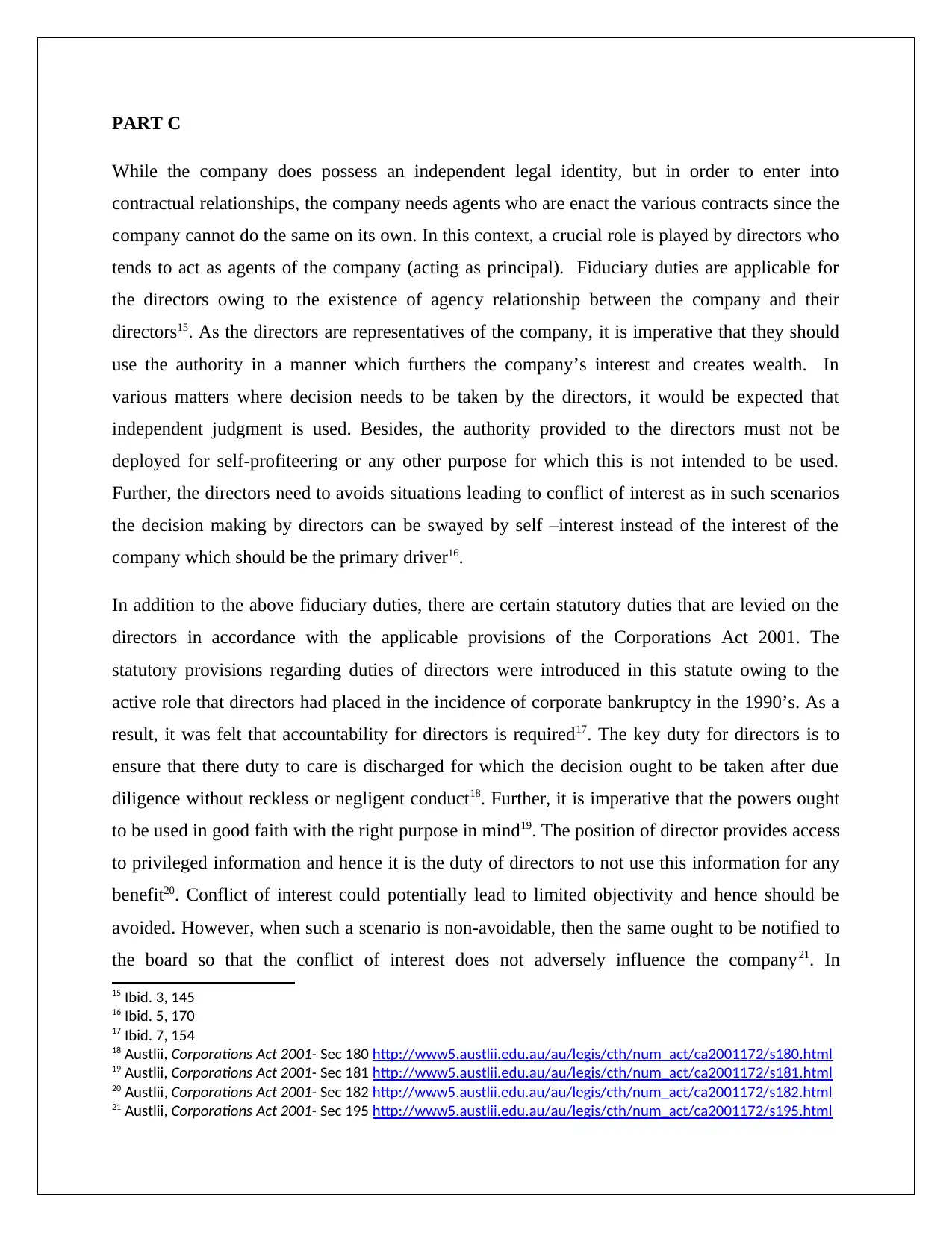
PART C
While the company does possess an independent legal identity, but in order to enter into
contractual relationships, the company needs agents who are enact the various contracts since the
company cannot do the same on its own. In this context, a crucial role is played by directors who
tends to act as agents of the company (acting as principal). Fiduciary duties are applicable for
the directors owing to the existence of agency relationship between the company and their
directors15. As the directors are representatives of the company, it is imperative that they should
use the authority in a manner which furthers the company’s interest and creates wealth. In
various matters where decision needs to be taken by the directors, it would be expected that
independent judgment is used. Besides, the authority provided to the directors must not be
deployed for self-profiteering or any other purpose for which this is not intended to be used.
Further, the directors need to avoids situations leading to conflict of interest as in such scenarios
the decision making by directors can be swayed by self –interest instead of the interest of the
company which should be the primary driver16.
In addition to the above fiduciary duties, there are certain statutory duties that are levied on the
directors in accordance with the applicable provisions of the Corporations Act 2001. The
statutory provisions regarding duties of directors were introduced in this statute owing to the
active role that directors had placed in the incidence of corporate bankruptcy in the 1990’s. As a
result, it was felt that accountability for directors is required17. The key duty for directors is to
ensure that there duty to care is discharged for which the decision ought to be taken after due
diligence without reckless or negligent conduct18. Further, it is imperative that the powers ought
to be used in good faith with the right purpose in mind19. The position of director provides access
to privileged information and hence it is the duty of directors to not use this information for any
benefit20. Conflict of interest could potentially lead to limited objectivity and hence should be
avoided. However, when such a scenario is non-avoidable, then the same ought to be notified to
the board so that the conflict of interest does not adversely influence the company21. In
15 Ibid. 3, 145
16 Ibid. 5, 170
17 Ibid. 7, 154
18 Austlii, Corporations Act 2001- Sec 180 http://www5.austlii.edu.au/au/legis/cth/num_act/ca2001172/s180.html
19 Austlii, Corporations Act 2001- Sec 181 http://www5.austlii.edu.au/au/legis/cth/num_act/ca2001172/s181.html
20 Austlii, Corporations Act 2001- Sec 182 http://www5.austlii.edu.au/au/legis/cth/num_act/ca2001172/s182.html
21 Austlii, Corporations Act 2001- Sec 195 http://www5.austlii.edu.au/au/legis/cth/num_act/ca2001172/s195.html
While the company does possess an independent legal identity, but in order to enter into
contractual relationships, the company needs agents who are enact the various contracts since the
company cannot do the same on its own. In this context, a crucial role is played by directors who
tends to act as agents of the company (acting as principal). Fiduciary duties are applicable for
the directors owing to the existence of agency relationship between the company and their
directors15. As the directors are representatives of the company, it is imperative that they should
use the authority in a manner which furthers the company’s interest and creates wealth. In
various matters where decision needs to be taken by the directors, it would be expected that
independent judgment is used. Besides, the authority provided to the directors must not be
deployed for self-profiteering or any other purpose for which this is not intended to be used.
Further, the directors need to avoids situations leading to conflict of interest as in such scenarios
the decision making by directors can be swayed by self –interest instead of the interest of the
company which should be the primary driver16.
In addition to the above fiduciary duties, there are certain statutory duties that are levied on the
directors in accordance with the applicable provisions of the Corporations Act 2001. The
statutory provisions regarding duties of directors were introduced in this statute owing to the
active role that directors had placed in the incidence of corporate bankruptcy in the 1990’s. As a
result, it was felt that accountability for directors is required17. The key duty for directors is to
ensure that there duty to care is discharged for which the decision ought to be taken after due
diligence without reckless or negligent conduct18. Further, it is imperative that the powers ought
to be used in good faith with the right purpose in mind19. The position of director provides access
to privileged information and hence it is the duty of directors to not use this information for any
benefit20. Conflict of interest could potentially lead to limited objectivity and hence should be
avoided. However, when such a scenario is non-avoidable, then the same ought to be notified to
the board so that the conflict of interest does not adversely influence the company21. In
15 Ibid. 3, 145
16 Ibid. 5, 170
17 Ibid. 7, 154
18 Austlii, Corporations Act 2001- Sec 180 http://www5.austlii.edu.au/au/legis/cth/num_act/ca2001172/s180.html
19 Austlii, Corporations Act 2001- Sec 181 http://www5.austlii.edu.au/au/legis/cth/num_act/ca2001172/s181.html
20 Austlii, Corporations Act 2001- Sec 182 http://www5.austlii.edu.au/au/legis/cth/num_act/ca2001172/s182.html
21 Austlii, Corporations Act 2001- Sec 195 http://www5.austlii.edu.au/au/legis/cth/num_act/ca2001172/s195.html
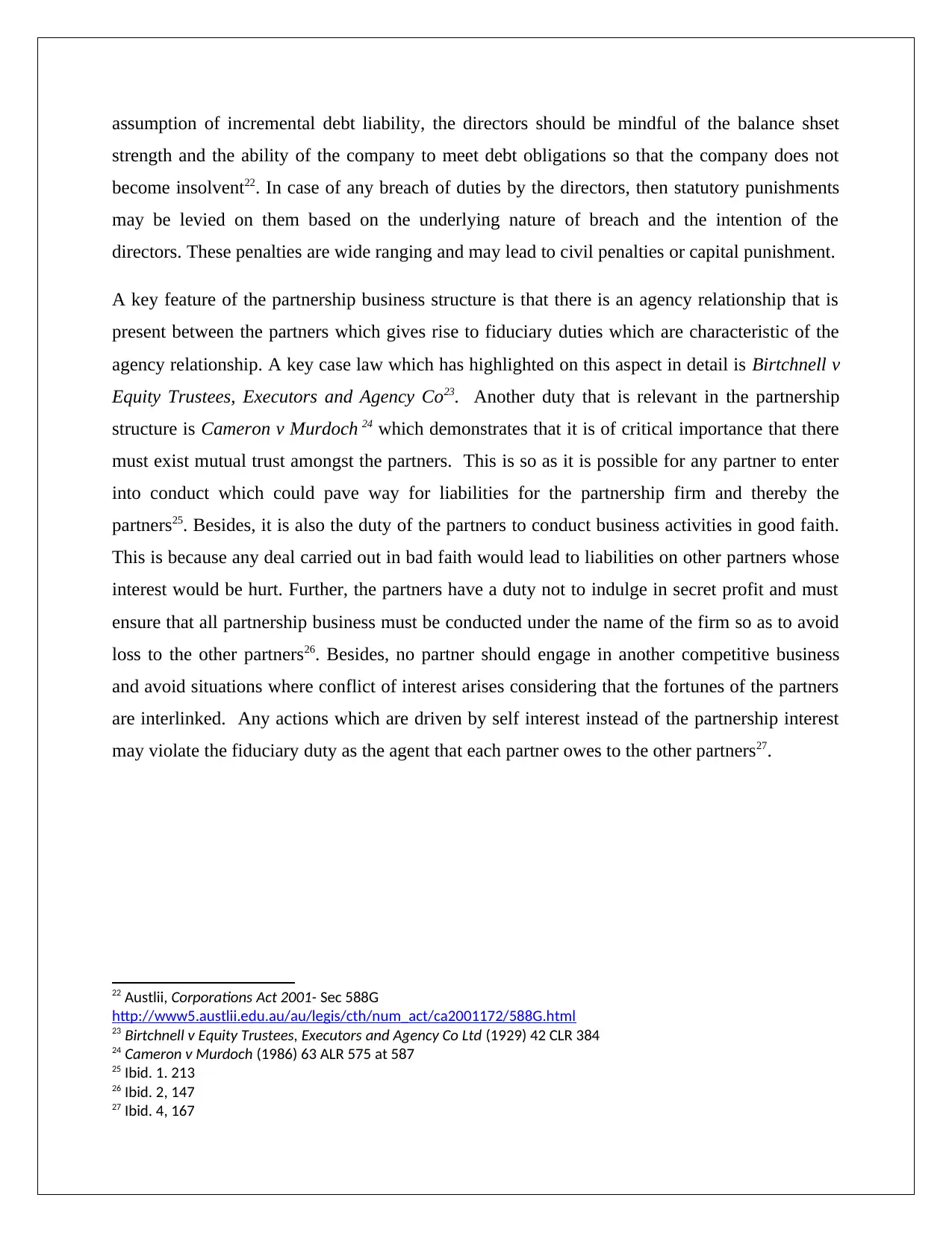
assumption of incremental debt liability, the directors should be mindful of the balance shset
strength and the ability of the company to meet debt obligations so that the company does not
become insolvent22. In case of any breach of duties by the directors, then statutory punishments
may be levied on them based on the underlying nature of breach and the intention of the
directors. These penalties are wide ranging and may lead to civil penalties or capital punishment.
A key feature of the partnership business structure is that there is an agency relationship that is
present between the partners which gives rise to fiduciary duties which are characteristic of the
agency relationship. A key case law which has highlighted on this aspect in detail is Birtchnell v
Equity Trustees, Executors and Agency Co23. Another duty that is relevant in the partnership
structure is Cameron v Murdoch 24 which demonstrates that it is of critical importance that there
must exist mutual trust amongst the partners. This is so as it is possible for any partner to enter
into conduct which could pave way for liabilities for the partnership firm and thereby the
partners25. Besides, it is also the duty of the partners to conduct business activities in good faith.
This is because any deal carried out in bad faith would lead to liabilities on other partners whose
interest would be hurt. Further, the partners have a duty not to indulge in secret profit and must
ensure that all partnership business must be conducted under the name of the firm so as to avoid
loss to the other partners26. Besides, no partner should engage in another competitive business
and avoid situations where conflict of interest arises considering that the fortunes of the partners
are interlinked. Any actions which are driven by self interest instead of the partnership interest
may violate the fiduciary duty as the agent that each partner owes to the other partners27.
22 Austlii, Corporations Act 2001- Sec 588G
http://www5.austlii.edu.au/au/legis/cth/num_act/ca2001172/588G.html
23 Birtchnell v Equity Trustees, Executors and Agency Co Ltd (1929) 42 CLR 384
24 Cameron v Murdoch (1986) 63 ALR 575 at 587
25 Ibid. 1. 213
26 Ibid. 2, 147
27 Ibid. 4, 167
strength and the ability of the company to meet debt obligations so that the company does not
become insolvent22. In case of any breach of duties by the directors, then statutory punishments
may be levied on them based on the underlying nature of breach and the intention of the
directors. These penalties are wide ranging and may lead to civil penalties or capital punishment.
A key feature of the partnership business structure is that there is an agency relationship that is
present between the partners which gives rise to fiduciary duties which are characteristic of the
agency relationship. A key case law which has highlighted on this aspect in detail is Birtchnell v
Equity Trustees, Executors and Agency Co23. Another duty that is relevant in the partnership
structure is Cameron v Murdoch 24 which demonstrates that it is of critical importance that there
must exist mutual trust amongst the partners. This is so as it is possible for any partner to enter
into conduct which could pave way for liabilities for the partnership firm and thereby the
partners25. Besides, it is also the duty of the partners to conduct business activities in good faith.
This is because any deal carried out in bad faith would lead to liabilities on other partners whose
interest would be hurt. Further, the partners have a duty not to indulge in secret profit and must
ensure that all partnership business must be conducted under the name of the firm so as to avoid
loss to the other partners26. Besides, no partner should engage in another competitive business
and avoid situations where conflict of interest arises considering that the fortunes of the partners
are interlinked. Any actions which are driven by self interest instead of the partnership interest
may violate the fiduciary duty as the agent that each partner owes to the other partners27.
22 Austlii, Corporations Act 2001- Sec 588G
http://www5.austlii.edu.au/au/legis/cth/num_act/ca2001172/588G.html
23 Birtchnell v Equity Trustees, Executors and Agency Co Ltd (1929) 42 CLR 384
24 Cameron v Murdoch (1986) 63 ALR 575 at 587
25 Ibid. 1. 213
26 Ibid. 2, 147
27 Ibid. 4, 167
⊘ This is a preview!⊘
Do you want full access?
Subscribe today to unlock all pages.

Trusted by 1+ million students worldwide
1 out of 6
Related Documents
Your All-in-One AI-Powered Toolkit for Academic Success.
+13062052269
info@desklib.com
Available 24*7 on WhatsApp / Email
![[object Object]](/_next/static/media/star-bottom.7253800d.svg)
Unlock your academic potential
Copyright © 2020–2025 A2Z Services. All Rights Reserved. Developed and managed by ZUCOL.





